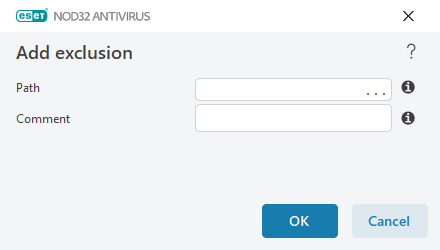Add or Edit performance exclusion
This dialog window excludes a specific path (file or directory) for this computer.
Choose path or type manually To choose an appropriate path, click ... in the Path field. When typing manually, see more exclusion format examples below. |

You can use wildcards to exclude a group of files. A question mark (?) represents a single character, whereas an asterisk (*) represents a string of zero or more characters.
Exclusion format •If you want to exclude all files and subfolders in a folder, type the path to the folder and use the mask * •If you want to exclude doc files only, use the mask *.doc •If the name of an executable file has a certain number of characters (with varying characters) and you only know the first one (for example, "D”), use the following format: Examples: •C:\Tools\*—The path must end with the backslash (\) and asterisk (*) to indicate that it is a folder and all folder content (files and subfolders) will be excluded. •C:\Tools\*.*—Same behavior as C:\Tools\* •C:\Tools—Tools folder will not be excluded. From the scanner perspective, Tools can also be a file name. •C:\Tools\*.dat—This will exclude .dat files in the Tools folder. •C:\Tools\sg.dat—This will exclude this specific file located in the exact path. |
System variables in exclusions You can use system variables like %PROGRAMFILES% to define scan exclusions. •To exclude the Program Files folder using this system variable, use the path %PROGRAMFILES%\* (remember to add backslash and asterisk at the end of path) when adding to exclusions. •To exclude all files and folders in a %PROGRAMFILES% subdirectory, use the path %PROGRAMFILES%\Excluded_Directory\* |
Wildcards in the middle of a path are not supported Using wildcards in the middle of a path (for example C:\Tools\*\Data\file.dat) may work but is not officially supported for the performance exclusions. There are no restrictions to using wildcards in the middle of a path when using detection exclusions. |
Order of exclusions •There are no options to adjust the priority level of exclusions using the top/bottom buttons. •When the first applicable rule is matched by the scanner, the second applicable rule will not be evaluated. •The fewer the rules, the better the scanning performance. •Avoid creating concurrent rules. |
